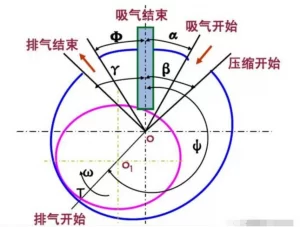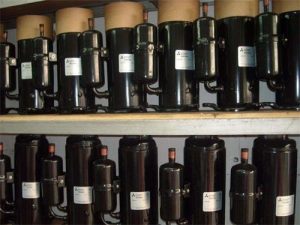Rotary compressor
1. Working principle
The helical rotor grooves are filled with gas as they pass through the suction port. When the rotor rotates, the rotor groove is closed by the casing wall to form a compression chamber. When the rotor groove is closed, the lubricating oil is sprayed into the compression chamber to seal. Cooling and lubrication. When the rotor rotates to compress the lubricant + gas (referred to as the oil-air mixture), the volume of the compression chamber decreases, and the oil-air mixture is compressed to the exhaust port. When the compression chamber passes through the exhaust port, the oil-air mixture is discharged from the compressor, completing a suction-compression-exhaust process.
(1) The rotor rotates once, which will complete the compression and exhaust process of the previous working cycle and the suction process of the next working cycle.
(2) Since there is no steam inlet valve, the timing of the start of suction has a strict correspondence with the position of the suction orifice on the cylinder, which does not change with the change of working conditions.
(3) Due to the setting of the exhaust valve, the timing of the end of compression will vary with the pressure in the exhaust pipe.

2. Application of rotary compressor
The rotor refrigeration compressor is fully enclosed and is generally used in household air conditioners or small refrigeration equipment. It is also widely used in household refrigerators. The refrigeration capacity of the compressor is not high, ranging from 3KW to 15KW.
3. Advantages of rolling rotor compressors
(1) The structure is simple, the volume is small, and the weight is light. Compared with the piston compressor, the volume can be reduced by 40% to 50%, and the weight can also be reduced by 40% to 50%;
(2) Fewer parts, especially less wearing parts, and less friction loss between relatively moving parts;
(3) Only the sliding vane has a small reciprocating inertial force, the rotating inertial force can be completely balanced, the speed can be high, the vibration is small, and the operation is stable;
(4) There is no suction valve, the suction time is long, the clearance volume is small, and the direct suction reduces the harmful overheating of the suction, so its efficiency is high.




